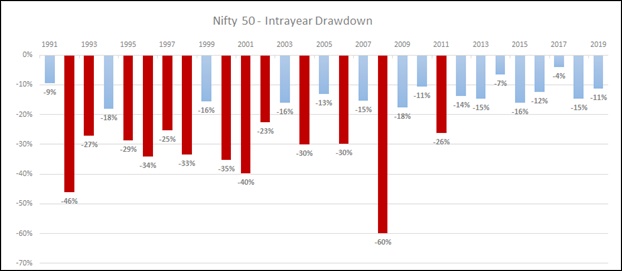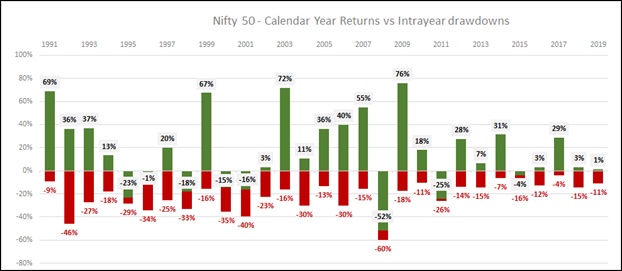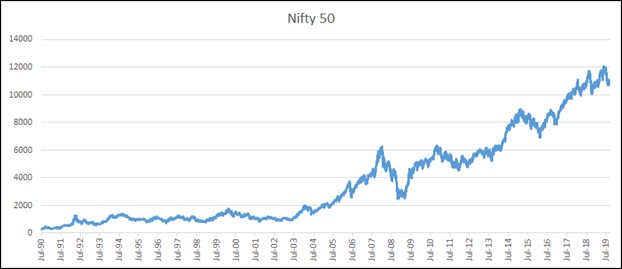At some point in time, every year, the market has fallen below its peak. The average intra-year decline has been -22 percent for the last 29 years. Till 2011, intra-year corrections of more than 20 percent were very common, as seen by the red bars ( chart below). Post-2011, the intra-year declines have mostly been in the range of 10-15 percent. This also coincides with a period of low volatility across global equity markets led by stimulus from major central banks.
So a 10-30 percent intra-year correction is almost a given and has occurred in 20 out 29 years (i.e 2 out of 3 years.)
The chart below shows the maximum fall in Nifty from the highest value it reached during the year, to the lowest. The bars marked in red represent falls exceeding 20 percent.

Now if you had seen this chart alone, would you still invest in Nifty?
Let’s add one more interesting data point and check if your view changes.

Despite substantial intra-year drops, the calendar year returns have been positive in 21 years out of the 29 examined. In other words, only 8 declines have led to a negative year.
If we isolate the positive calendar years, the average intra-year decline is still around 18 percent.
Sample this:
- In 2006, the intra-year decline was a whopping 30 percent. Yet, the entire year returns was a positive 40 percent
- In 2004, the intra-year decline was a whopping 30 percent. Yet, the entire year returns was a positive 11 percent
This shows how common market declines are, and how difficult it is to predict if a large intra-year decline will result in negative returns, over the entire year.
Further, even in years with negative returns, the final return has usually been a lot better than the intra-year decline would have suggested.
Now I guess, you will be able to appreciate the fact that while near term declines are inevitable, majority of them don’t lead to large declines.
Now, will you invest in equities?
Let‘s show you the bigger picture as well.

In the last 29 years (01-Jan-1991 till 31-Aug-2019), The Nifty index has given 13% CAGR or in other words, has gone up 33 times!
Conclusion
The longer-term returns in equities have corresponding fees to be paid, though the returns are decent. This is paid in terms of the emotional uncertainty that you will have to go through each and every time there is a 10% decline and you are worried what if this turns out to be the next big one.
Now, to be honest, most of us assume we can get out before the big crash happens. It is extremely difficult and we would advise building your asset allocation assuming that you can’t do it.
While we can get a sense of where we are in the cycle by evaluating valuations, fundamentals and sentiments, and will attempt to reduce risk if we enter a bubble market, a few crashes will still remain unpredictable. Humility and patience remain a central part of our investment strategy.
Market declines can be difficult for you. But, reacting emotionally and changing long-term investment plans in response to short-term declines could prove more harmful than helpful. Stick to a time tested evidence-based plan, ideally agreed upon in advance of sharp market decline periods. This might help you remain calm during periods of temporary short-term uncertainty.
This article was originally published on Financial Express on October 3rd, 2019.








The stock market’s unpredictable behavior is what scares most of the individuals. But you have to learn how to use stock market crashes to your benefits. You can invest in commodities like gold that performs better during stock market conditions. Also, one should not be afraid of long term investments just because the market can crash. If you invest for the long term, chances of higher returns increase.